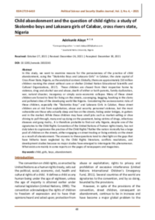This study examined the reasons for the pervasiveness of the practice of child abandonment, using the “Skolombo Boys and Lakasara Girls’’ in Calabar, the state capital of Cross River State, Nigeria, as the analytical context. Globally, there are approximately 150 million children roaming the street without care or shelter (United Nation Educational Scientific and Cultural Organizations, 2017). These children are chased from their respective home by violence, drug and alcohol use and abuse, death of either or both parents, family dysfunction, war, natural disaster, insurgency or simply socio-economic collapse. Many of these street children are forced to fend for living on the streets, scavenging, begging, hawking in the slums and polluted cities of the developing world like Nigeria. Considering the socioeconomic risks of these children, especially the “Skolombo Boys” and Lakesera Girls in Calabar, these street children are at risk from exploitation, abuse and security personnel violence, but the most vulnerable are those who actually sleep and live on the streets, hiding under bridges, in gutters and in the market. While these children may have small jobs such as market-selling or shoe shining to pull through, many end up dying on the pavement, being victims of drugs, infectious diseases and gang rivalry., It is therefore probable to find out why Nigeria, despite one of the signatories to the Child Rights Convention of the United Nations of human rights treaty, has not duly taken to cognizance the practice of the Child Rights? Rather the nation ironically has a large pool of children on the streets, either engaging on street trading or living entirely on the street as a result of abandonment. The answers to these questions tend to shed light on the gaps that have hitherto been neglected by the Child Rights literature, conflicts resolutions, and development studies because no major studies have emerged to interrogate this phenomenon. What exists are mainly in some reports on the pages of newspapers and magazines.

